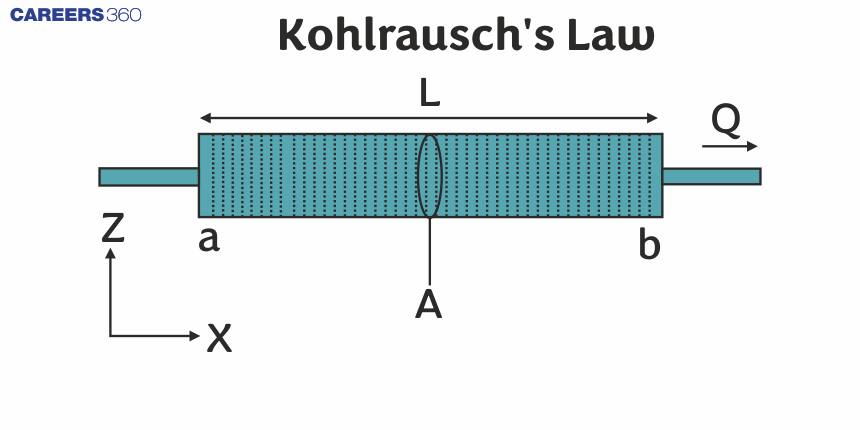Kohlrausch's Law
Kohlrausch's Law of Independent Migration of Ions was derived from his work on the conductivity of electrolytes. The law states that the limiting molar conductivity of an electrolyte can be expressed as the sum of the contributions from the individual ions, each ion contributing independently to the total conductivity.
NEET 2025: Mock Test Series | Syllabus | High Scoring Topics | PYQs
JEE Main: Study Materials | High Scoring Topics | Preparation Guide
JEE Main: Syllabus | Sample Papers | Mock Tests | PYQs
- Kohlraush's Law
- Molar Conductance at Infinite Dilution -
- Some Solved Examples
- Summary

Kohlraush's Law
Kohlrausch examined Λo or Λ∞ values for many strong electrolytes and observed certain regularities. He noted that the difference in Λo of the electrolytes NaX and KX for any X is nearly constant.
Based on these observations, he introduced Kohlrausch's law of Independent Migration of ions. The law states that limiting molar conductivity of an electrolyte can be represented as the sum of the individual contributions of the anion and cation of the electrolyte that is, at infinite dilution, the contribution of any ion towards equivalent conductance is constant; it does not depend upon the presence of any ion.
For any electrolyte:
Application of Kohlrausch's Law
- Determination of
In the case of weak electrolytes, the degree of ionization increases which increases the value of Λm. However, it cannot be obtained by extrapolating the graph. The limiting value, Λm∞, for weak electrolytes can be obtained by Kohlrausch law. - To determine the degree of dissociation and equilibrium constant of weak electrolyte:
C 0 0
C-C
Here
HereThese are Ostwald's relations.
- To determine the solubility of salt and Ksp:
If the solubility of AgCl is M and K and has values in
. Here
Solubility product:
Molar Conductance at Infinite Dilution -
When the addition of water doesn’t bring about any further change in the conductance of a solution, this situation is referred to as Infinite Dilution.
Strong Electrolytes: When infinite dilution is approached, the conductance of a solution of strong electrolyte approaches a limiting value and can be obtained by extrapolating the curve between Λm and c1/2
All electrolytes having the same formula type have the same value of B e.g. (KCl, NaCl) and (CaCl2, MgCl2)
The molar conductivity of strong electrolytes is found to vary with concentration as
where B is a constant depending upon the type of electrolyte, the nature of the solvent, and the temperature. This equation is known as the Debye Huckel-Onsage equation and is found to hold good at low concentrations.Weak Electrolytes: When infinite dilution is approached, the conductance of a solution of the weak electrolyte increases very rapidly and thus, cannot be obtained through extrapolation. Also, the variation between Λm and c1/2 is not linear at low concentrations.
Recommended topic video on (Kohlrausch's Law)
Some Solved Examples
Example.1
1. The molar conductivities
1)
2)
3)
4) (correct)
Solution
From the reaction,
or
Thus to calculate the value of
Hence, the answer is the option (4).
Example.2
2. The equivalent conductances of two strong electrolytes at infinite dilution in
What additional information/quantity one needs to calculate
1)
2) (correct)
3)
4)The limiting equivalent conductance of
Solution
According to Kohlrausch’s law, the molar conductivity at infinite dilution
So, for calculating the value of
Hence, the answer is the option (2).
Example.3
3. Match the column I with column II
a) Kohlrausch Law p)
b)
c) K r)
d)
1) (correct)a -r, b- s, c- q, d -p
2)a -s, b- r, c- q, d -p
3)a -r, b- s, c- p, d -q
4)a -s, b- r, c- p, d -q
Solution
Kohlrausch's law states that the equivalent conductivity of an electrolyte at infinite dilution is equal to the sum of the conductances of the anions and cations. If salt is dissolved in water, the conductivity of the solution is the sum of the conductances of the anions and cations.
According to Kohlrausch's law,
Molar conductivity is given by,
The degree of dissociation is given by,
So, Correct Match => a -r, b- s, c- q, d -p
Hence, the answer is the option (1).
Example.4
4. A = At infinite Dilution, the equivalent conductance is the sum contribution of its constituent ions.
R = At infinite dilution, each ion makes a definite contribution towards equivalent conductance of electrolyte irrespective of the nature of the ion it is associated with
1) (correct)A & R are correct and R explains A
2)A & R are correct and R doesn't explain A
3)A is correct but R is not
4)A & R are incorrect
Solution
Kohlrausch's law of independent migration of ions - The law states that limiting the molar conductivity of an electrolyte can be represented as the sum of the individual contributions of the anion and cation of the electrolyte. R explains A correctly
Hence, the answer is the option (1).
Example.5
5. The conductivity of 0.02 M Acetic acid is
1)
2)
3) (correct)
4)
Solution
Application of Kohlrausch's law - Calculation of molar conductivities of weak electrolytes at infinite dilution.
Hence, the answer is the option (3).
EXAMPLE.6
6. The incorrect equation is:
1) (correct)
2)
3)
4)
Solution
Kohlrausch's law follows here
Both sides are not equal.
Hence, the answer is the option(1).
Summary
Kohlrausch’s Law provided a fundamental understanding of ionic mobility and conductivity. Kohlrausch’s Law allows for the calculation of the individual mobilities of ions in an electrolyte solution. By measuring the conductivity of the solution, one can determine the mobility of each ion, which is crucial for understanding how ions move in various conditions.
Also Read
07 Feb'25 11:49 PM
07 Feb'25 12:44 PM
07 Feb'25 12:24 PM
07 Feb'25 12:20 PM
19 Oct'24 03:02 PM
10 Oct'24 11:27 AM
10 Oct'24 11:24 AM
10 Oct'24 07:54 AM
10 Oct'24 01:02 AM

